Seen & Heard: An Important Notice for Local Businesses
••• You know how shady lawyers are taking advantage of the Americans with Disabilities Act to screw businesses large and small? They find a business with a step or two at the entrance and then say they’ll sue (on behalf of a disabled person who claims to have tried to enter unsuccessfully), but they’ll gladly accept a settlement instead. I know of four businesses around here to have been victims of this. Do not tell yourself that your business is too small. Ann Benedetto of the Tribeca Alliance sent over some useful information that anyone with such a storefront—there are many like that in this area—should really pay attention to (and she says that members of the Alliance will soon get an update as well):
1. It can cost an average of $10,000 between your lawyer and the plaintiff’s lawyer. It is worth knowing how to protect your business.
2. Small businesses, look at your lease (i.e. standard leases in paragraph 6): Tenants are liable for all laws present and future that includes the American Disability Act. Not knowing is not an excuse. Landlords want to make tenants responsible for just about everything they can.
3. Before this becomes an issue, discuss it with your landlord and maybe you can come up with a plan—they too can be sued, so it’s to their advantage. Better to know up front than to be caught off guard.
4. Look at your business’s insurance and see if you are covered for lawsuits. If you are covered, they do your bidding; if not, you are responsible to answer the lawsuit.
5. Know the status of your building. If it’s a Landmark building, you have to check with the Landmark Preservation Commission to see if the ADA law pertains to the historic building in question.
6. If you have a step or two at your entrance, invest in a portable ramp and a handicap logo with a phone number for assistance. They are not expensive compared to the lawyers’ fees.
UPDATE: Please read James’s comment for much more information on this topic.
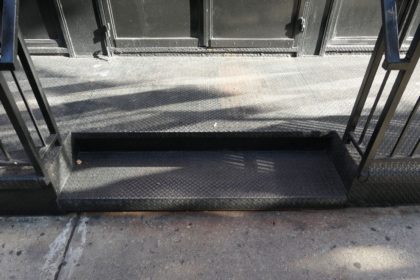 ••• At least some of the cobblestones on Greenwich are being repaired. Maybe it’s a test, so they know they can get it right this time?
••• At least some of the cobblestones on Greenwich are being repaired. Maybe it’s a test, so they know they can get it right this time?
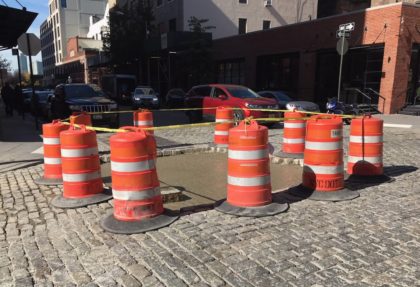 ••• The TV show “Succession” will be back in the area (W. Broadway/Thomas) on Monday. And the TV show “Billions” (a.k.a. Possible Productions) is in the Church/Reade area on Tuesday. The shoots have been non-stop lately.
••• The TV show “Succession” will be back in the area (W. Broadway/Thomas) on Monday. And the TV show “Billions” (a.k.a. Possible Productions) is in the Church/Reade area on Tuesday. The shoots have been non-stop lately.
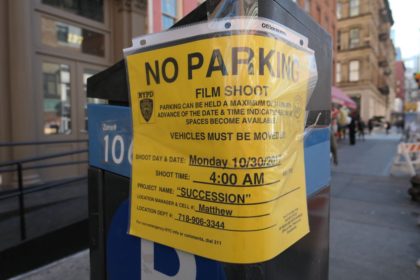
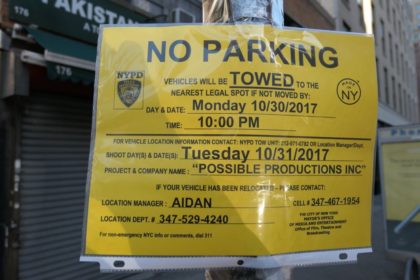 ••• Up now at Cheryl Hazan: a group show featuring Hunt Slonem, Louise Crandell and Luis Garcia Nerey. Below: Slonem’s “Cabbage Patch.”
••• Up now at Cheryl Hazan: a group show featuring Hunt Slonem, Louise Crandell and Luis Garcia Nerey. Below: Slonem’s “Cabbage Patch.”
 ••• I’m not especially into the Louis Vuitton brand (or any brand, really), so the newly opened exhibition at the old American Stock Exchange Building (86 Trinity Place) left me unmoved, although many of the installations are impeccably done. I had been hoping to get a sense of the building, but beyond the grotty escalators, we could’ve been in the Javits Center. So if you think it might be up your alley, take David G. Imber‘s advice: “I strongly recommend the Louis Vuitton exhibition. Whether you’re interested in the history of fashion, or how travel influenced design, or just enjoy truly outstanding craftsmanship I think there’s lots to see for everyone. LV did an amazing job transforming the building, which I’d never been in, despite living a stone’s throw from it for most of my life. And it’s free!” (Well it had better be, since it’s all a big marketing ploy!) The best part, for me, was the kiss someone named Brooke left in the guest book.
••• I’m not especially into the Louis Vuitton brand (or any brand, really), so the newly opened exhibition at the old American Stock Exchange Building (86 Trinity Place) left me unmoved, although many of the installations are impeccably done. I had been hoping to get a sense of the building, but beyond the grotty escalators, we could’ve been in the Javits Center. So if you think it might be up your alley, take David G. Imber‘s advice: “I strongly recommend the Louis Vuitton exhibition. Whether you’re interested in the history of fashion, or how travel influenced design, or just enjoy truly outstanding craftsmanship I think there’s lots to see for everyone. LV did an amazing job transforming the building, which I’d never been in, despite living a stone’s throw from it for most of my life. And it’s free!” (Well it had better be, since it’s all a big marketing ploy!) The best part, for me, was the kiss someone named Brooke left in the guest book.






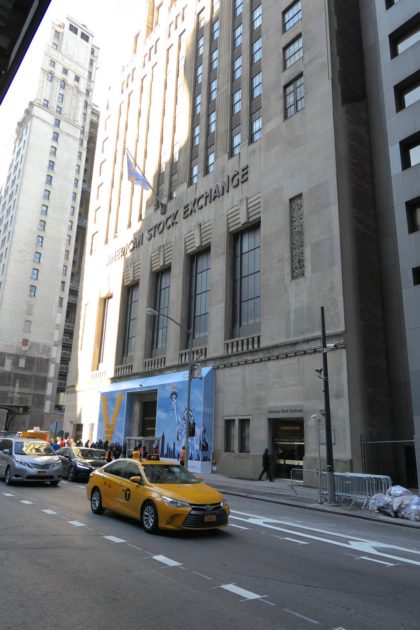








Does ADA apply to a home office (not a “professional office”, i.e. not open to the general public)? I only invite selected colleagues and clients there. No employees; it’s a single-member LLC (I am the sole member).
(Also it’s a landmarked building)
Americans with Disabilities Act Title III Regulations
Part 36 Nondiscrimination on the Basis of Disability in Public Accommodations and Commercial Facilities
(current as of January 17, 2017)
§ 36.104 Definitions […]
Place of public accommodation means a facility operated by a private entity whose operations affect commerce and fall within at least one of the following categories –
(1) Place of lodging, except for an establishment located within a facility that contains not more than five rooms for rent or hire and that actually is occupied by the proprietor of the establishment as the residence of the proprietor. For purposes of this part, a facility is a “place of lodging” if it is –
(i) An inn, hotel, or motel; or
(ii) A facility that –
(A) Provides guest rooms for sleeping for stays that primarily are short-term in nature (generally 30 days or less) where the occupant does not have the right to return to a specific room or unit after the conclusion of his or her stay; and
(B) Provides guest rooms under conditions and with amenities similar to a hotel, motel, or inn, including the following –
(1) On- or off-site management and reservations service;
(2) Rooms available on a walk-up or call-in basis;
(3) Availability of housekeeping or linen service; and
(4) Acceptance of reservations for a guest room type without guaranteeing a particular unit or room until check-in, and without a prior lease or security deposit.
(2) A restaurant, bar, or other establishment serving food or drink;
(3) A motion picture house, theater, concert hall, stadium, or other place of exhibition or entertainment;
(4) An auditorium, convention center, lecture hall, or other place of public gathering;
(5) A bakery, grocery store, clothing store, hardware store, shopping center, or other sales or rental establishment;
(6) A laundromat, dry-cleaner, bank, barber shop, beauty shop, travel service, shoe repair service, funeral parlor, gas station, office of an accountant or lawyer, pharmacy, insurance office, professional office of a health care provider, hospital, or other service establishment;
(7) A terminal, depot, or other station used for specified public transportation;
(8) A museum, library, gallery, or other place of public display or collection;
(9) A park, zoo, amusement park, or other place of recreation;
(10) A nursery, elementary, secondary, undergraduate, or postgraduate private school, or other place of education;
(11) A day care center, senior citizen center, homeless shelter, food bank, adoption agency, or other social service center establishment; and
(12) A gymnasium, health spa, bowling alley, golf course, or other place of exercise or recreation.
Thank you for that.
I guess a home office is not considered a “commercial facility” so hopefully I’m fine…
It’s true that one doesn’t get much of a sense of the original building at the Vuitton show. It was once a huge, functional (somewhat dreary) pastiche [ http://tinyurl.com/yaffkgmd ]. What impressed me was the transformation. True also about the small, weirdly speedy escalators…
I’m also kind of a sucker for certain small, anecdotal details like the notes on VIPs’ special requests. People like Audrey Hepburn and Mme. Bogart [slash] Robards, [ http://tinyurl.com/ycvg7hry ]
Don’t know why the link failed, but there’s no editing on these comments, so if you’re curious: http://tinyurl.com/ycvg7hry
The link works for me….
Re: ADA issues for retailers
This is very useful information for small businesses to know. I would add a couple of detailed comments. There is a legitimate need to provide barrier-free access for the disabled, but it has been opened up for abuse.
1. Negotiate legal fees from a position of strength:
When the ADA law was written, the politicians (mostly lawyers) figured they would minimize legalized abuse of retailers by limiting the lawsuits to improving access and allowing only nominal amounts that plaintiffs could collect as money damages. However the same politicians (again, mostly lawyers) reasoned it was unfair to put any limit on the reimbursement of the plaintiff’s legal fees. That is why and how the shady lawyers can and do enlist plaintiffs to sue multiple businesses; the lawyers allegedly kick back some of the legal fees settlement to the plaintiffs.
If you are sued and are the victim of one of these scams, your lawyer should quickly pull every case from the federal courts’ database where the plaintiff’s lawyer–either with the same plaintiff or otherwise–sued a retailer. You will find that the filings are all identical, cut-and-paste jobs where only the names, dates, locations, and observations are changed. (Some lawyers file many cases against many stores all on the same day, in an unjustifiably short time period.) Thus, when plaintiff’s lawyer demands reimbursement of thousands of dollars in legal fees, you can argue that the lawyer and/or client is a scammer (a “vexatious litigant”) who sues repeatedly and spent maybe a few hundred dollars at most on your case to quickly fill in a template that he or she has used over and over again in previous cases.
These lawyers want to make a quick settlement and run. They really do not want to actually conduct discovery and a trial.
2. Take responsibility for the inside of your premises.
Retail and restaurant tenants are certainly responsible for the interior layouts of and the sales fixtures in their stores. Plaintiffs have no problem simultaneously arguing (i) that they could not enter your store and (ii) nevertheless plaintiff observed non-ADA-compliant conditions inside your store (despite not being able to enter your store) perhaps through a window.
These interior conditions include but are not limited to:
* use of accessible door hardware (levers, not knobs, for example)
* width of aisles, paths, and door frames
* location and height of merchandise and shelves and display racks and tables and chairs and other furniture
* location and height of sales counters
* type and nature of flooring surface
* training of store personnel in ADA issues
* compliance of handicap restroom (for most restaurants with 20 seats or more) including: grab bars, wider toilet partitions, insulating lavatory pipes under sinks to prevent burns, raised toilet seat, accessible (lever) faucet handles, full-length bathroom mirror, accessible paper towel dispenser, etc.
3. Do not wait for (or expect much from) your landlord.
If there is any easy way for your landlord to help comply, they might. If you expect your landlord to do any construction in the absence of a lawsuit, that is doubtful.
4. Think carefully about relying on your liability insurance, i.e., nothing is for free.
Insurance carriers do nothing for free. If you give them the case to defend, they will usually accept the defense, as the duty to defend is a broad one. However, the insurance carrier will keep track of the cost of the defense and any settlement payout or award of damages. Then when your annual policy comes up for renewal, they will likely raise your premium to earn back their costs.
5. Do not think that Landmark status or building age will shield you from responsibility for providing “barrier-free access”.
The ADA law makes one responsible for providing access that is “readily achievable,” that is “easily accomplishable and able to be carried out without much difficulty or expense.” What this means is always up for debate between litigants and lawyers.
One defense against a permanent alteration for a Landmark building (or in a Landmarked district) would be to argue that to add a ramp, for example, would threaten or destroy the historic or architectural significance of the building. However, Landmarks routinely grants permits to add ramps and lifts, etc. The Building Code provides that buildings built prior to 1970 may build a ramp on the sidewalk even if it extends up to 44 inches from the building line.
It may not be a winning defense to argue that a ramp would not strictly comply with ADA regulations (too steep, etc.), if it were feasible to install and would otherwise improve access to the premises.
If restoration or other work has been done on the storefront or on the access to the store since the ADA law was enacted (as per photographs or filings with Landmarks or Buildings Department), then one will have an even harder time arguing that Landmark or historic status makes removing barriers to access not readily achievable.
Finally, remember that Landmark status generally applies to the exterior of buildings. It will not necessarily exempt one from needing to remove barriers to access inside a retail store or restaurant.
6. There are other accommodations that are also not permanent constructions, aside from temporary ramps.
* Provide for home delivery service;
* Provide signage that sales clerks will retrieve inaccessible merchandise upon request;
* Provide wireless, handheld devices for sales clerks to come out from behind the sales counter to ring up customers’ purchases, process credit card payments, print sales receipts, etc.
* Provide partial accessibility in a store or restaurant.
Note also that, instead of a phone number, one can mount a wireless doorbell next to a handicap sign (with the receiver mounted to ring inside the store).
Aren’t old entrance steps from decades ago grandfathered in? That is, they are legal unless making an alteration.
ADA is essentially a civil rights law that is enforced by private or federal government litigation. No one is grandfathered or exempt from providing access to a public accommodation. One would have to argue that changing the old steps or providing alternative access is not “readily achievable” or would destroy historic features of a building.
What about the Canal St Post Office? They had an opportunity for a ramp or a small elevator (as in the West 18th St P.O.) during a recent renovation on their Church St. Side. Is the Federal Government exempt from this?
I understand as a matter of law, the Postal Service is subject to the Architectural Barriers Act, rather than the ADA. (If the building is privately owned, said owner is covered by ADA.)
With respect to the Federal Government, ADA does not cover the executive branch of the Federal government; instead it is covered by title V of the Rehabilitation Act of 1973, which is similar. ADA does cover Congress and other entities in the legislative branch of the Federal government. The Federal judiciary, however is covered by neither the ADA nor the Rehabilitation Act.
This is what’s happening in Toronto to help small businesses be accessible http://stopgap.ca. Well named, the project is actually a stop gap measure put in place in advance of an AODA compliance deadline in 2025. It’s a terrific example of community engagement and a pro-active approach to an important accessibility mandate.